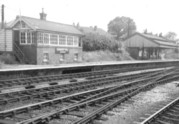
In April 1956, I obtained the position of relief signalman based at Wembley Hill where there were four running lines from Blind Lane signalbox, which was just north of Wembley Hill station and from where the four running lines went through to Neasden Junction. I learned and relieved the boxes in the area, being at Sudbury Hill Harrow station, at Sudbury and Harrow Road station, at Blind Lane, at Wembley Hill station and at Neasden North. At Neasden North, on the way from Neasden Junction towards Wembley Hill, High Wycombe and further from Princes Risborough, there were large freight yards on both sides of the running lines and the signalbox was quite large for the long lever frame.
I also relieved at Brent North signalbox on the main line from and to Marylebone, via Neasden Junction, and to Harrow-on-the-Hill and Aylesbury, and, in those days, beyond. That line was originally the Great Central Railway. At the Brent North signalbox there was a junction for freight trains in and out of Neasden goods yards. Near there was Wembley Park, the Metropolitan line station. I also had the passenger trains on the main lines from and to Marylebone. At certain intervals a steam engine from Neasden Junction would pass on its way to Rickmansworth, about eleven miles, where it would take over the next Metropolitan train from London for Aylesbury. The electric engine would be shunted into a siding at Rickmansworth ready to take over the next Metropolitan train from Aylesbury to London, Baker Street. In those days there was no electrification of the Metropolitan line farther north than Rickmansworth, but later on electrification was extended for about six miles to Amersham. The Metropolitan trains there now terminate and British Rail diesel trains run all the way, thirty-seven and a half miles, from Marylebone to Aylesbury Bucks. My wife and I went to Nottingham Victoria from Harrow-on-the-Hill shortly before the line north of Aylesbury was scrapped. A private railway society called Quainton Railway Society Ltd [now the Buckinghamshire Railway Centre] had an extension of the line north of Aylesbury for about six miles as far as what was Quainton Road station.
On a weekend, when I worked as pilotman between Neasden Junction and Harrow-on-the-Hill station, I remember the signal cabin at the Harrow end which was located high up in the buildings above the station platforms. The lever frame had miniature levers which controlled the Metropolitan trains as well as the British Rail trains which use Harrow-on-the Hill station. That was the only occasion when I could see that miniature lever frame.
I well remember an unfortunate experience I had when I was relieving on nights at Neasden North. The date was 1 October 1957. Many times during the nights there were transfers from one yard to the other yard on the other side of the running lines, through crossovers with slips linking four running lines. I had plenty of pulling and pushing of the point and lock levers throughout the night. The shunting engine was a 0-6-0 diesel and had two red lights, one on the front and one on the back. It was a very dark night and some wagons were being drawn from one yard to the other, through the ladder of points across the four running lines. Some of the wagons immediately behind the shunting engines were flat wagons. The engine red light was normally obscured by other wagons and vans, but this time I actually saw the red light and thought it was on the rear of the wagons. I started to restore the points to normal, thinking that the wagons were all across. My too early movement of the points caused the derail of a wagon. Of course, I had to immediately send the 'obstruction danger' signal on the block instruments to the signalboxes in each direction. Three of the four running lines were unable to be used for the normal business trains in the morning, and the remaining running line had to be arranged as single line for using both ways, until normal working could be resumed later that day. A letter dated 29 October 1957, addressed to me from the Operating Department, Western Region, stated: 'The responsibility for this mishap rests with you owing to the fact that the points were restored before the wagons had past clear. In view of your clear record, it is agreed to pass the case with a warning to exercise more care in future.'
When the Football (Cup Final) took place at Wembley Stadium, special trains were run between Marylebone and what was a Stadium Station which was a loop line from Neasden North box and round to the Stadium for football fans and back to Marylebone empty, then load up again and back as often as required. As the end of the Cup Final came the football trains would be used again to take the football fans back to Marylebone. I worked Neasden North signalbox sometimes on that very busy special Cup Final occasion, and usually the signal inspector would also be in signalbox. Marylebone and most of the lines which had been joint between the Eastern Region and Western Region, being the areas in which I had worked most of the signalboxes, were, in February 1958, transferred to the London Midland Region. However, I had the option of remaining with the Western Region which I did, and, in 1958 I was successful in obtaining a post as relief signalman at Greenford in which I relieved, after learning, at Greenford West, Park Royal and North Acton.